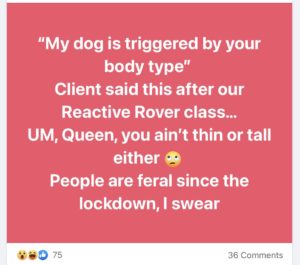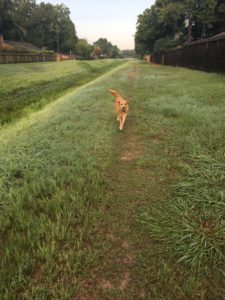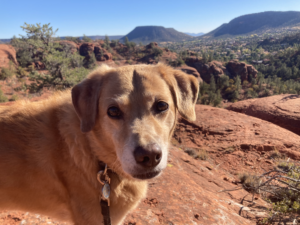Michael Baugh CDBC CPDT-KSA
Nineteen months ago, none of us really knew what was coming. Dog behaviorists and trainers predicted and increase in behavior problems from dog separation anxiety to puppy socialization issues to increased resource guarding. We got some of that right. We trainers also braced ourselves for a collapse in business. I had one other trainer working for me in April 2020. At the time I didn’t know whether or not we’d survive financially. In an interview with KTRH Radio in Houston I talked about how we were rebuilding our business model, just so we could make it. Some of our worries and associated predictions were well-founded. There were some increased (and interesting) behavior problems that cropped up. But we got another part completely wrong. Business was going to boom. In fact, we were about to be in over our heads with an increased demand for help.
 By some estimates pet ownership increased during the pandemic by more than 40-percent. People who had never had dogs before got dogs or puppies. People who had one or more dogs got a second or a third. By mid 2021 the trend was so apparent it became a meme (apparently air fryers sales did well too). At first glance this may look like great news. We all want to see more cats and dogs adopted – and that was happening. But as with many good things in life, there was a flip side.
By some estimates pet ownership increased during the pandemic by more than 40-percent. People who had never had dogs before got dogs or puppies. People who had one or more dogs got a second or a third. By mid 2021 the trend was so apparent it became a meme (apparently air fryers sales did well too). At first glance this may look like great news. We all want to see more cats and dogs adopted – and that was happening. But as with many good things in life, there was a flip side.
As early as Fall 2020 veterinary practices were becoming overwhelmed. All of these new dogs and cats needed medical care. Scheduling a standard vaccination appointment for tomorrow or the next day was off the table. The wait time became a week or two or more. Wait times for emergency care (unless your pet was critical) increased to as much as 8 hours. Even in normal times veterinary medicine is considered an at-risk profession with a higher-than-typical suicide rate (physicians and other caring professions are similarly at risk). Now, with the added cases and little time in the day to catch their breath, veterinarians are burning out. Many are leaving the profession or shifting specialties. Others are dying. Not One More Vet (NOMV) is an organization founded to help keep veterinarians healthy, alive, and in the profession they love. NOMV and your own personal vet will always appreciate your kindness and support.
Dog trainers and behavior consultants were caught in the storm of demand as well. We here at The Behavior Group had to adapt quickly. What started as a two person operation in March 2020 is now a five person operation. (See: Inside Michael’s Dogs – How We Survived 2020). We did well, but one of our trainers got buried under a huge caseload. She had to step away for break and then eventually left the group. While this person is doing exceptionally well now, other trainers have reportedly left the profession permanently. The ones who remain have full schedules with no openings for 2 to 3 months.
If you’re tempted to roll your eyes at my complaints about being too busy, I get it. Fair enough. The real problem goes beyond just that, though. None of this is happening in a vacuum. Veterinarians and we trainers are all tasked with helping people who, themselves, are under unprecedented pressure. This was literally the subject of my last newsletter. Life is hard right now. The real problem is a toxic blend of more dogs, more demand, and a client base that is hurting more than ever. I’m hearing about the fallout from my friends, fellow trainers, and vets. I’m also seeing it on social media. A well-respected trainer with more than 20-years experience recently posted that they’d considered closing their doors and quitting the profession. But why?
“What people don’t see, or hear, or read,” They wrote, “is what we take on every single day. The hysterical voicemails, the impossible cases that are immediate emergencies, the rude comments, the pressure of social media, the incessant demand for attention right away. The texts at 11pm [demanding] response or [they will write] a negative review. People truly have no idea. It is not playing with puppies all day.”
 Some people are, frankly, thoughtless and unkind. Another trainer put it in the form of a meme (left). “People are feral since the lockdown, I swear.”
Some people are, frankly, thoughtless and unkind. Another trainer put it in the form of a meme (left). “People are feral since the lockdown, I swear.”
Please do not misinterpret this is a cry for help. It is more of a peek behind the curtain – a look at how the sausage is made – choose your favorite metaphor. Covid puppies. Covid pets. This unexpected fallout. These are all our issues to take on as trainers and behavior consultants and as veterinary professionals. We know self-care. More importantly we know that caring for each other is even more powerful and essential.
I’m not claiming to have figured all this out. But, here is what we are doing in our group. A few months ago we brought on Stephen Kelly as our Client Care Lead. His role is to support our clients and our trainers, both. Stephen can help you with anything from rescheduling an appointment to fixing a typo on your email address in our files. He helps the trainers by assisting you as well, so they can focus on the thing they love – teaching and training. All of us work hard to communicate our process and what we have to offer (I think we set the standard in client learning and support).
We also clearly communicate our boundaries. Boundaries in our group are so important. It’s why we have a clear cancellation polity (this actually helps you plan better, too). We have boundaries around when we accept texts – not just from clients but from each other. This clarity about boundaries lets you know when you will have our full attention. We take days off. These days are do-not-enter zones for recharging our emotional and intellectual batteries. They are so important to us. But, don’t underestimate how important they are to you as well. A rested trainer is smarter, more creative in their teaching and training, and more empathetic.
Empathy. So much of our work is about standing with you as you navigate the path of learning with your dog (it is sometimes a difficult winding path). I’ve been here. I am here with you now. That’s empathy. First Aid Arts posted a Vimeo video with Brené Brown in which she says, “I find Empathy to be infinite. I think it gives back tenfold what you put out. It’s sustaining” There interviewer, named Travis, then jumps in and says, “If you’ve done the work and you have your boundaries you could tread that water forever.” Brown responds, “Okay so, Empathy. I’m quoting Travis here. Empathy. If you’ve done your work and set your boundaries you can tread that water forever. Amen!”
I’ll second that. Amen, indeed.
—
Michael Baugh teaches dog training in Houston, TX. He leads Michael’s Dogs Behavior Group – and amazingly talented team of people-care professionals.



